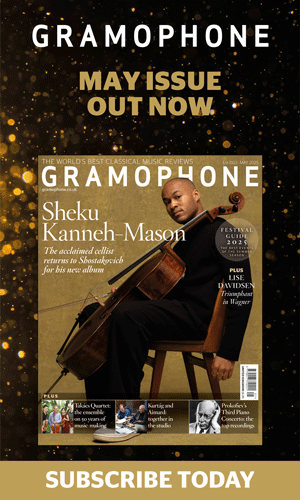Masterpieces Or Fakes? The Joyce Hatto Scandal (February 15, 2007)
Charlotte Smith
Monday, December 17, 2012

It was already one of the strangest stories the classical music world had witnessed. But the discovery of the late English pianist Joyce Hatto as the greatest instrumentalist almost nobody had heard of, appears to have taken a bizarre, even potentially sinister turn.
It was around a year ago that Gramophone’s critics began to champion this little-known lady, whose discs – miraculous performances, released by her husband William Barrington-Coupe on the tiny label Concert Artist – were notoriously difficult to get hold of. Such was the brilliance of this pianist across Liszt, Schubert, Rachmaninov, Dukas and more in a dizzying range – that it was worth making the effort to seek out Concert Artist to get these discs, and they became much sought-after. By the time she died in June 2006, Joyce Hatto was not only a sudden widespread success, she was a cause célèbre. To love Hatto recordings was to be in the know, a true piano aficionado who didn’t need the hype of a major label’s marketing spend to recognise a great thing when they heard it.
But at the same time as the cult of Hatto was burgeoning, there were persistent rumours on the internet as to the true origins of the recordings. How, wondered the doubters, could one woman – especially one who had battled cancer for many years – have mastered a range of repertoire and recorded a catalogue that arguably makes her more prolific than even the Richters and the Ashkenazys.
However, Gramophone critic Jeremy Nicholas published a letter in the magazine asking anyone who had any evidence of any wrong-doing to come forth. Nobody did, and the matter rested. Until now.
Several days ago, another Gramophone critic was contacted by a reader who had put a Hatto Liszt CD – the 12 Transcendental Studies – into his computer to listen to, and something awfully strange happened. His computer's player identified the disc as, yes, the Liszts, but not a Hatto recording. Instead, his display suggested that the disc was one on BIS Records, by the pianist Lászlo Simon. Mystified, our critic checked his Hatto disc against the actual Simon recording, and to his amazement they sounded exactly the same.
In then went a recording of Hatto playing two Rachmaninov Piano Concertos and, sure enough, his computer's CD player listed it as another – by Yefim Bronfman, conducted by Esa-Pekka Salonen, on Sony. Again, the critic compared, and again he could hear no difference.
Gramophone then sent the Hatto and the Simon Liszt recordings to an audio expert, Pristine Audio’s Andrew Rose, who scientifically checked the soundwaves of each recording. They matched. 'Without a shadow of a doubt,' reported Rose, '10 of the tracks on the Liszt disc are identical to those on the Simon'. Of the remaining two, he now feels that he has identified a further one – which he identified as being, again 'without a shadow of a doubt' from a CD entitled 'Nojima Plays Liszt', a 1993 release from Reference Recordings. Furthermore, his partner – who is based elsewhere with his own equipment – agrees.
More astonishing revelations were to come. The pair then checked a track from a Hatto disc of music by Godowsky, and found that it sounded strange, as if the sound had been tampered with. After running checks, they found that the music had indeed been manipulated – the time had been stretched by an 'audacious' 15.112 per cent (such an extreme stretch accounted for the odd sound) to alter the tone, but that if the stretch was reversed it became clear that the track was identical to that played by the pianist Carlo Grante on a CD issued by Altarus.
Rose even created special pages on his website, showing the soundwaves for both the Godowsky and the Liszt side by side with those they match. The listener can compare the tracks simultaneously. Rose later checked the Rachmaninov Concertos recording and, sure enough, it matched up with the Bronfman recording.
It would take many weeks of intensive work to examine all of the Hatto recordings, but it seems clear that at least some of these great performances are identical to other performances available from other recording companies. Contacted for his comments, Barrington-Coupe – who acknowledged that he produced well-nigh all of his wife’s recordings – was at a loss to explain the similarity.
Are the Hatto’s fakes? If so, how many? This, it must be suspected, is a story that won’t go away until the full truth is known.
Visit Pristine Audio's Hatto web page for further information.
Update, February 20, 2007
In a private email to one of our critics, William Barrington-Coupe has refuted any accusations of wrongdoing – adding that a friend of his had compared the Bronfman and Hatto Rachmaninovs and thought the Hatto far superior. Barrington-Coupe also, the critic reported to Gramophone, asserted that Hatto had made the Godowsky recording using her own hand-prepared copies of the scores made when she was 16. He further identified recording venues used for the recordings as mainly colleges and churches where he used mobile recording facilities. He stated his intention to have his own sound engineer prepare his own comparisons.
Update, February 21
Andrew Rose, of Pristine Audio, has today confirmed that at least one of the Godowsky Chopin Etudes on the disc released as being by Joyce Hatto, is the same as one from Marc-André Hamelin's recording of the work for Hyperion Records. A track from the release had already been identified as the same as one by pianist Carlo Grante on a CD issued by Altarus.
James Inverne, Editor, Gramophone







